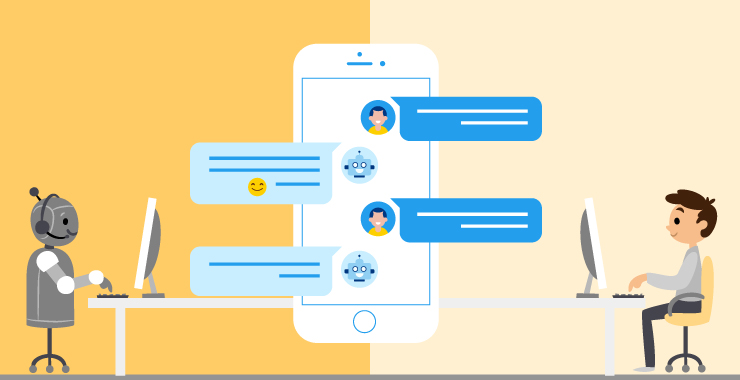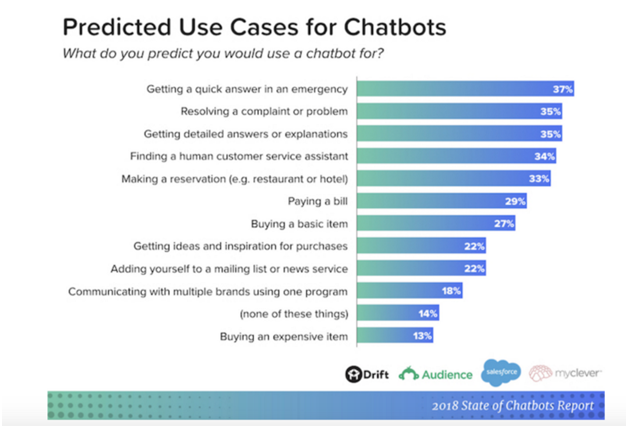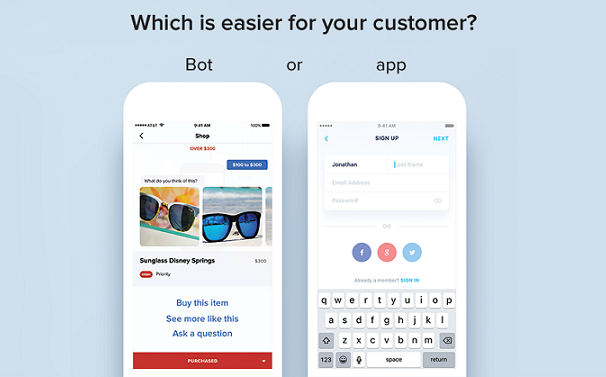Blog Tag: AI
How the Advent of Chatbots is Giving Way to Conversational Commerce?

As per the HubSpot research report, 56% of people would rather chat than call customer service and 53% of people are more likely to shop with businesses they can chat with.
Chat is the new email and as I’m sure, most people have noticed over the last few years messaging and chat applications have come to the fore. Most millennials or people who are slightly older tend to use chat rather than email.
Chat is the Natural Form of Conversation
One of the reasons why chat or messaging has become so prevalent is this that it’s a natural form of communication. If you’re using it from a mobile application, it works seamlessly from a mobile platform. The other thing is that you know messaging and chat has come a long way. We are a generation grownup in the heels of SMS messages, AOL Messenger and now WhatsApp. We are accustomed to the conversational UI that the previous generations.
Surprisingly, Baby Boomers (age 55+) are more likely to expect benefits from chatbots than Millennials (age 18–34). 83% of online shoppers need support during shopping. 71% of people use chatbots to solve their problem fast, a HubSpot research report indicates.
A Chatbot is more Intuitive than an App

Messaging is probably one of the most popular forms of communication for our generation and before it. Chatbot are virtual assistants for communicating via messaging or chat. On the surface, they are yet another program, which communicates to a user through messaging or a chat interface. However, they don’t really issue commands. They give you a response you talk to it as you would a normal person. Chatbots target a particular use-case, provide a particular service, or focus on answering particular types of questions.
Conversational Commerce in Action

Isabella wants to use a chatbot to order some new business cards to reflect a new role in her organization. The type of conversation she might have is fairly free-form. She’s not issuing commands. She’s typing in what she wants to do so her interaction is in the blue and because she’s interacting with a chat bot which has context, it knows who she is and what she wants to do to an extent it can provide smart suggestions.

The suggestions make the whole interaction a lot simpler, slicker than it would be if you’re going to an application which you’ve never used before.
Chatbot can ask things like you know I notice that your role has changed in the HCM system would you like to use your new role in your new business cards. It gives the opportunity to reply yes or no. Moreover, it also previews a card with Isabella’s new role.

Then it would nicely ask, “do you want me to place the order now I’ve modified the business card for you” and “do you want me to place the order and send them to you. If she answers affirmatively, it gives her the opportunity to say where she wants the business cards to be sent.

Did you notice? The chatbot made the whole process quick, simple and easy. To order business cards, she did not have to log in to any specific applications, learn how to use any particular applications and could converse with it in natural language.
Significance of Conversational Commerce in the World of Mobile Commerce

What you’re trying to get away with chatbot is the traditional user interface. You’d see with applications you issue commands, which are very mechanical. Chatbots make the experience of electronic commerce a more natural experience and with that, they bring some other concerns.
There’s no such thing as a free lunch. You make it easier to use but then you introduce other things when you’re dealing with an application, which are screens, gestures, menu, etc.
On the other hand, when you introduce a chat bot you actually feel like you’re talking to someone. You feel like they have a personality there. Other things come into play, for instance, you know you have to think about the customer sentiment. Certain tasks may not be suitable for a chatbot. if you have a chat bot to support customer support desk of your ecommerce business, it will have to handle complaints, which will make you think how the customer are going to react and how should the bot should respond appropriately.
An Opinionated Chatbot is Better Suited for Conversational Commerce

There are all sorts of different things you need to start thinking about and you might want to give your chatbot a personality. Many ecommerce brands give their chatbots names. In a sense, they’re trying to make them appear like an actual person. The usual practice with chatbots is to be very upfront with users: you’re talking to a machine, not a person.
However, inevitably people start to think the actual even though they know it’s an actual machine they’re talking to. They tend to assume that they are talking to a person but you can do clever things.
If you’ve got some context about the person you’re communicating with, you can fashion the style of conversation accordingly and build a personality around the chatbot. If they are younger, maybe they will be more formal. If they’re older maybe the type of conversation you’re having requires a different type of personality.
AI, Machine Learning, Natural Languages Processing, and Chatbots

Among the things that has led to the rise of chatbots and increased interest in them is the increased interest in artificial intelligence as well as providing a simple user interface to have a conversation to achieve typical ecommerce tasks like payment and adding shipping address.
The improvements or the greater availability of toolkits and services around artificial intelligence have helped develop very simple messaging application to make them much more sophisticated and two areas of artificial intelligence which played a big role in this are natural language processing and machine learning .
The two areas of artificial intelligence: Machine Learning and Natural Languages Processing allow to break apart the conversation or the questions that a person is asking to find out which pieces of that text are important and to determine what their intent is. Chatbots allow you to have that conversation with them because you can deduce—what they’re saying, what they actually want you to, what you want to do, what information they seek from you.
Of course, chatbots are great and can actually be fun talking to rather than just typing in and clicking on menus, etc.
A chatbot isn’t a person after all, no matter how hard it tries

There are times when no matter how good the artificial intelligence, which sits behind a chatbot is, chatbots are going run out of answers. The questions become more ad hoc, complicated or the chat bot starts to ask things, which the chatbot was never designed to deal with and at that point you need to really hand off to a real person.
All that matters
That process of actually interacting with someone via chat and then handing over to a real person, to a real service representative, to deal with customer’s questions needs to be as seamless as possible.
You need to pass the context on so that the person doesn’t have to go and ask the customer what they wanted, again. They have to go through the whole rigmarole of explaining their problem.
Artificial Intelligence (AI) and the Future of Web Development

“A year spent in Artificial Intelligence is enough to make one believe in God – Alan Perlis”
The Internet has evolved a lot since its birth and it has made web development evolve as well – website building was a very easy process that involved nothing more than pages of standard text with few pictures and font variations.
Fast forward a decade; society was gifted with standard web connections which enabled websites to develop on HTML and PHP, including graphics and animated design elements. Fast forward another two decades – today with the advancement of technologies, web development consists of a mix of images and audiovisual content designed to deliver the best user experience rather than just information.
As per the recent news, the humanoid robot Sophia has been made a citizen of Saudi Arabia. Was that something ever expected? Additionally, Gartner predicts, “By 2020, customers will manage 85% of their relationship with the enterprise without interacting with a human”.
So, here the question arises, with whom will they interact? The answer is quite simple – via Artificial Intelligence (AI);
i.e. simulation of human intelligence processes by machines that includes learning, reasoning, and self-correction. For instance: Siri, Cortana, Chat-bots, self-driving cars, etc are delivering optimal user experience with the help of AI.
Today, as Web Development focuses on enhancing the user experience; small, medium as well as large enterprises are looking forward to leveraging the power of Artificial Intelligence in web applications for providing personalization and boosting their web experience.
Why is Important Artificial Intelligence (AI)?
- Automates repetitive learning and discovery through deeper data
- Adds intelligence
- Adapts progressive learning algorithm
- Achieves incredible accuracy
Let’s check out how Artificial Intelligence is changing the scenario of web development:
-
Better Predictive Reply
A predictive reply is the process of interaction between users and machines. The machine fails to understand the human’s emotion but Artificial Intelligence can understand the same and responds accordingly.
This helps in getting quick answers, making it easy for customers and businesses to resolve their queries. Recently, Google updated the Gmail app with an AI-driven “Smart Reply” feature that predicts responses you may want to send.
The feature uses a machine learning algorithm to analyze your emails and suggest quick, bite-sized responses you may want to send. What it does is, it tries to understand the email message and predicts what preferable responses you can give.
Chatbots powered by AI, interact with the user in a natural way leaving no scope for misunderstanding and enriching the user experience. To be precise, you can create websites or web-enabled devices that can communicate like a human in an effective manner.
-
Voice-based search
Voice-based search empowered with Artificial Intelligence is the key driver in enabling seamless voice conversation between users and websites. Siri, Cortana, and Alexa can do virtually anything from assisting you to setting alarms, scheduling meetings, controlling and checking the status of smart-home devices, making and receiving phone calls, getting directions, etc.
As the user interacts with the virtual assistant, they can learn about your voice, intent, preferences and much more as the AI backend code uses a sophisticated algorithm to learn from the data input; predicting the user’s need in a better way. And by doing this, it learns how to work with you better as well as serve you in an enhanced way.
Virtual assistance can be an integral part of all e-commerce web players to enhance web experience and shopping in a smarter way. Digital Assistance also maintains privacy policies, which define how each company uses and shares personal information.
-
Machine learning
Machine learning technology – the element of Artificial Intelligence has come along a broader way to provide customization in websites and personalization to the users. It predicts the user’s intention by analyzing previous activities and accordingly adjusts messages based on the interactions and behaviors.
Machine learning makes use of algorithms to make computers learn without being explicitly programmed. Through machine learning the application analyzes data that helps to automate the analytical model building, enabling the systems to find hidden insights. It applies complex mathematical calculations to the big data – over and over, faster and faster to predict future problems and prevent them from occurring.
Some popular scenarios of machine learning used in a web application are:-
- Online recommendation offers from Amazon, eBay, etc
- Spam detection in form submissions
- Search engines
-
Boosts the content-quality
It is easily said ‘Trigger the right message to the right buyer’, but doing it is altogether a different challenge. In this digital era, which is the best way to present relevant content to every person who engages with your brand?
The precise answer is, through Artificial Intelligence. It helps the web-marketers to create relevant content for their audience at every phase of the marketing funnel. With the help of algorithms, robust analysis, and scrutinizing the data of competitors, it is easier to gather information about the target audience which includes their likes and preferences.
With such insights, you can curate your content and provide relevant answers to boost customer engagement and rank high on conversions.
-
Provides unique store experience
Retailers use Artificial Intelligence to analyze customer data in order to gain insights into customers’ behavior. It provides a personalized approach to each customer by offering shopping recommendations, deals, discounts, and much more.
Chatbots, an extremely multi-faceted tool, is able to detect the tone of the user’s message and determine the best way of responding. AI enables online retailers to boost sales and forecast demand, to gain a better understanding of consumer behavior.
Wrapping it up
Artificial Intelligence is an advanced and decisive technology that adds value to the user experience and organizations. In the coming years, AI will play a crucial role in bringing the web and users close to each other.
Do you want to enhance the user experience of your web application? Get in touch with us and we will get back to you with the most robust solution.
Frequently Asked Questions
1. Why is Artificial intelligence gaining importance?
Artificial intelligence helps automate repetitive learning, add intelligence, adapt progressive learning algorithms, and achieve accuracy.
2. What kind of applications require Artificial Intelligence?
Web and mobile applications that require a better predictive response, voice-based searches, and machine learning can benefit from Artificial Intelligence.
3. What are the famous machine learning cases used in web applications?
Some of the best applications are online recommendations of offers and discounts from Amazon, eBay, etc., Spam detection in form submissions, and Search engines.
4. How can AI offer a personalized experience for customers?
Artificial Intelligence provides a personalized experience by offering shopping recommendations, deals, discounts, and more. Implementing chatbots can detect the user’s tone and determines the best way to respond. AI is becoming the future of web development as it helps boost sales, better understand consumer behavior, and forecast demand.
artificial intelligence in web applications | Artificial Intelligence In Web Development

